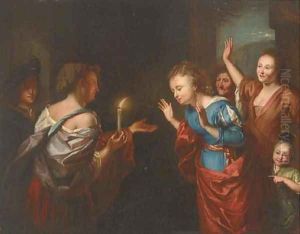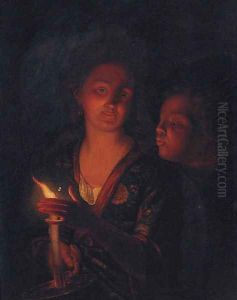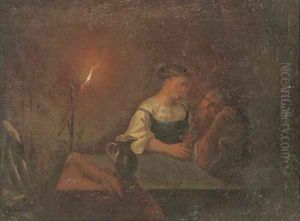Godfried Schalken Paintings
Godfried Schalken was a Dutch Golden Age painter and a student of Gerrit Dou. Born in Made, near Dordrecht in the Netherlands, on August 1643, Schalken initially trained with the lesser-known artist Samuel van Hoogstraten before moving to the workshop of Gerrit Dou, one of Rembrandt's most famous students. This apprenticeship had a profound impact on Schalken's technique and subject matter, as Dou was known for his exquisite detail and dramatic use of light and shadow, a style that would come to be known as fijnschilder, or fine painting.
After completing his training, Schalken developed a distinctive style characterized by his use of artificial light sources, such as candles and lamps, to create intimate, nocturnal scenes. These works often featured a combination of strong chiaroscuro and meticulous detail, qualities that made his paintings highly sought after by collectors. His subjects were varied and included genre scenes, portraits, and religious subjects, often with a sense of drama and emotion.
Schalken's talents extended beyond painting; he was also a skilled engraver and mezzotinter. His reputation spread beyond the borders of the Netherlands, and he even spent some time in England, where he painted portraits of notable figures, including King William III. Despite his time abroad, Schalken's work remained deeply rooted in Dutch artistic traditions, and he continued to influence and contribute to the Dutch Golden Age of painting.
Godfried Schalken passed away in The Hague in November 1706. His works continue to be admired for their technical skill and innovative use of light, and they can be found in numerous museum collections around the world, including the National Gallery in London, the Rijksmuseum in Amsterdam, and the Metropolitan Museum of Art in New York.


